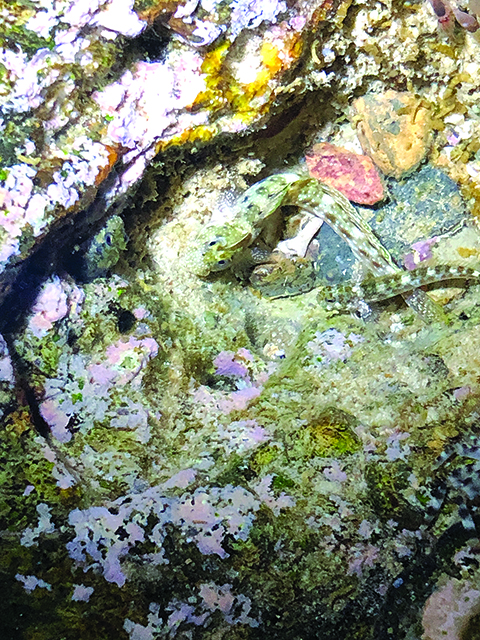
WHAT ARE ROCKSKIPPERS?
Rockskippers are fish that spend most of their time out of water. During the day, they graze for algae on the rocks. To eliminate competition from other fish, they like to graze on algae that are out of the sea water, either in puddles above the sea water or on rock surfaces out of water. However, they always stay close to the sea or to bigger puddles during the day, so that when birds, monitors or cats appear, they can easily jump and dive to safety.

The month of March used to beacon the onset of the beach and swimming season in Palawan. March to May is the time of year when the wind is calm and the sky is clear. The sea tends to be very still that there are days when the water looks like an endless sheet of glass.
It is sad that the COVID-19 pandemic has drastically altered our lifestyle and habits. Since March of 2020, the usually crowded tourist destinations like Port Barton and El Nido have been quite deserted and have reverted back to the sleepy town scene that they used to be before year 2000.

RE-WILD, REWIND
For someone who likes animals and enjoy pristine nature, I noticed that wild creatures are resurfacing. It is like they are reclaiming territory from people.
I am guessing that the absence of human activity outdoors have emboldened the animals to reoccupy areas near human settlements. I have observed this phenomenon not only in the beaches of Puerto Princesa City, but also in El Nido when I went there with my family for a weekend of R&R on March 19, 2021.
I did not plan on writing this story or think of taking pictures of animals, so I did not bring my camera or GoPro, but advances in technology enable us to take pictures with our cellphones. Otherwise, I will be kicking myself in the head if I had missed the opportunity. I never expected to encounter so many interesting creatures on this trip.
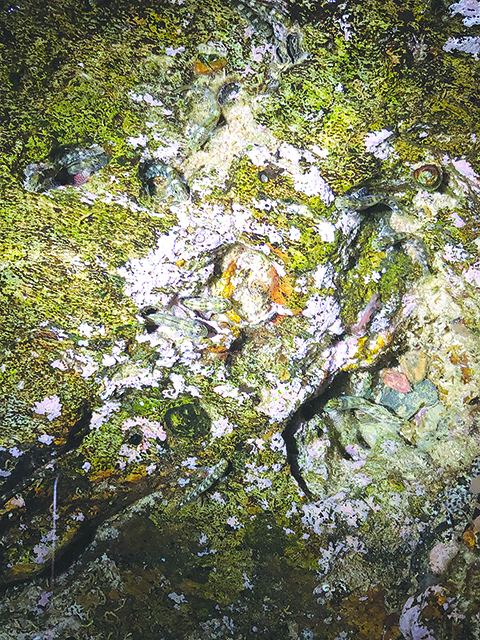
RARE FIND
I was walking with my youngest daughter along the beach of Sitio Maremegmeg after a hearty dinner. I brought a flashlight because, based on previous experience, I knew that a lot of fish would stay still when blinded by light, enabling me to observe them for longer periods of time than I could during the day.
The walk on the beach was uneventful at first, until we came upon huge jagged rocks lying just above the water line on low tide. I was delightfully surprised to see groups of fish resting together in and around small pools dotting the rock surface I have seen Rockskippers on rare occasions before, but they were always solitary and clinging to cliff or rock surfaces above deep or turbulent water, making them hard to observe.
I have never seen them congregate in groups of more than two individuals and I have not seen them at night time. The sight of them huddling together in pools no bigger than a fruit platter is truly an amazing sight, not to mention that these are the largest specimens I have encountered so far, with the big ones surpassing the three-inch mark from head to tail.
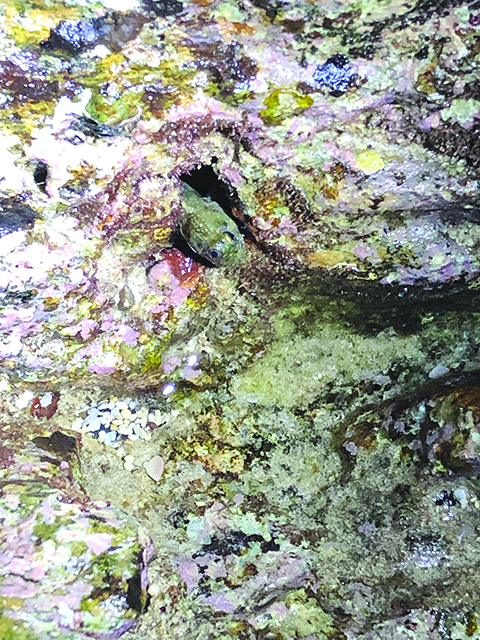
SKIPPERS AND JUMPERS
As I lingered for a few seconds to observe the cute critters, their eyes got accustomed to the light and they recognized our presence. Very shortly, a scampering fest ensued.
As their name implies, they are terrific jumpers and skippers. They can skip not only on dry land or rock surfaces but on water surface as well. They can also use their front fins to climb on rock surfaces. Sometimes I wonder if these guys are descended from a lizard dad and a fish mom.
My daughter squealed with joy as dozens of Skippers splashed around us. Some of them jumped out of the puddles towards the sea, while others swam to deeper parts of the bigger puddles. A few were able to swim towards cracks and, to my amazement, quite a number knew where small moist caves were located, which were out of water but moist with algae.
Like vehicles that were about to park in a crowded mall parking area, they crawled towards the cave, turned their body 180 degrees, then entered the cave tail first, so that their eyes would face out of the cave, capable of assessing when it was safe to come out once again.
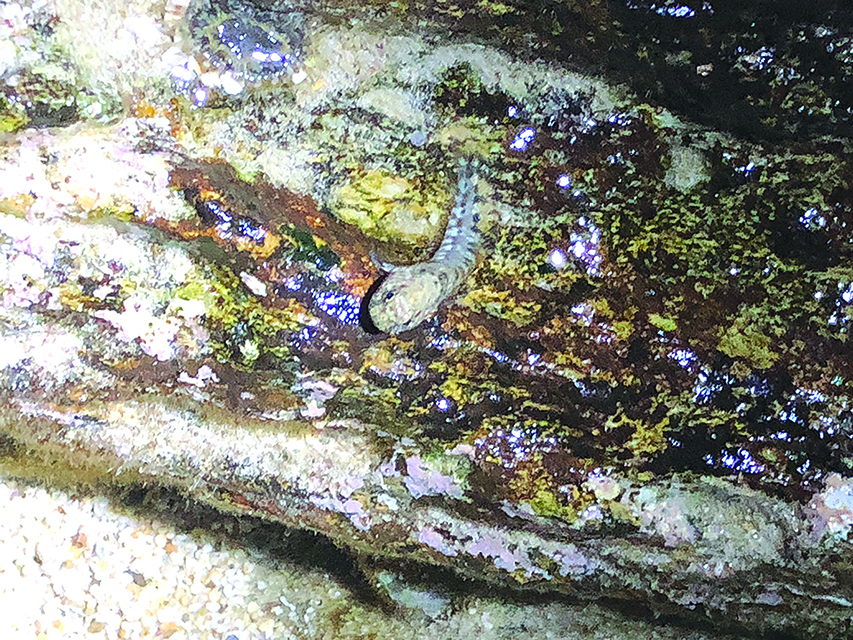
THE “BLINK”
As I try to recall my encounters with the remarkable Rockskipper, my mind drifts to a more familiar creature with whom I have a lot of fond memories with… the Rockskipper’s naughty cousin, the Mudskipper. One outrageous thing that I observed with Mudskippers that I have yet to see with Rockskippers is that they actually blink.
I did some research to confirm my observation, because I could not quite assure myself that Mudskippers blinked like people. My brief internet search both confirmed and debunked my observation. It turns out that the Mudskipper does blink in order to keep its eyes wet, but not with closing eyelids like humans. Rather, their bulging eye is retracted down into the eye socket.

ROCKSKIPPERS VS. MUDSKIPPERS
There are some amazing characteristics that separate Rockskippers and Mudskippers from other fishes. One, of course, is their ability to stay on land. They actually spend almost all of their time on land and they only get into the water mainly to escape from predators or to travel faster. One 1998 study by Malcolm S. Gordon titled African Amphibious Fishes and the Invasion of the Land by the Tetrapods states that they spend more than 90% of their time out of water.
I try to imagine my dog spending 90% of her time under water, and it is just mind boggling. This paper states that the Skippers breathe through their gills by storing water in them, and also through their skin.
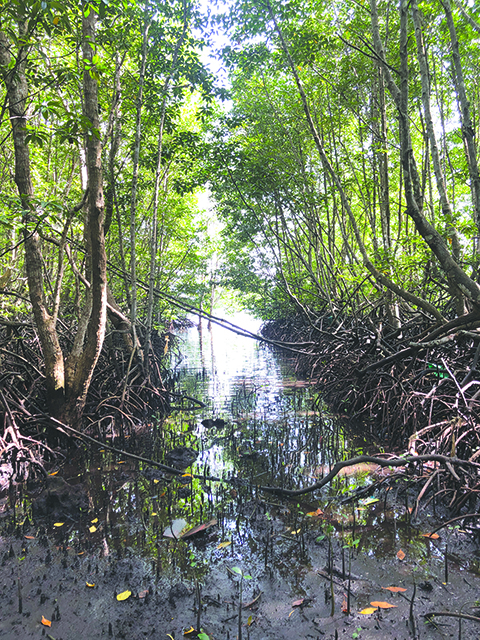
HOW BIG DO MUDSKIPPERS GET?
Speaking of decent size, it was not unusual to see our local Mudskipper growing up to five inches long from head to tail. I also remember seeing Skippers in the pier during the 80s about 11 inches long. I suspect these are also of different species from the common ones I see at the mangrove swamps and on the sandy beaches.
MANGROVE MAINSTAYS
For as long as I can remember, I always see Mudskippers whenever I go to the beaches of Palawan. This leads me to believe that they are more versatile and adaptable than the Rockskippers. In fact, I have seen Rockskippers only in El Nido and not on the other countless beaches around the country that I have been to. Maybe the limestone cliffs and rocky beaches of El Nido are a big factor. After all, how can you be a Rockskipper if there are no rocks to skip on?
Despite the versatility of the Mudskipper, one thing that I am sure of is that their favorite habitat is the mangrove swamp. Whenever I walk or drive by a mangrove swamp, I can see dozens of these Skippers basking in the sun beside their favorite mud hole or relaxing while seemingly glued to mangrove stems and aerial roots.
During my childhood years before the 90s, Palawan was sparsely populated. I remember feeling a little scared to venture into the mangrove forests. While they looked kind of spooky, what really scared me was the army of Mudskippers numbering by the hundreds in every section of the swamp. I had the feeling that they were going to gang up on me like a bunch of Piranhas.
At the time, Mudskippers did not fear people yet, and they would gladly cling to the banca (boat) of the fishermen. They were so numerous that they bumped each other off the drift wood during high tide when a decent space of dry wood or rock was hard to come by. So when a banca was moored in their territory, it was prime Mudskipper real estate.
They really were fishes who loved to be out of water. While they were smart enough to steer clear of me by a foot or two, it was possible to hold them with my bare hands if I were to lunge my arm at them like a snake. Presently, I’d be lucky if I got myself two meters close to a decent-sized Mudskipper.
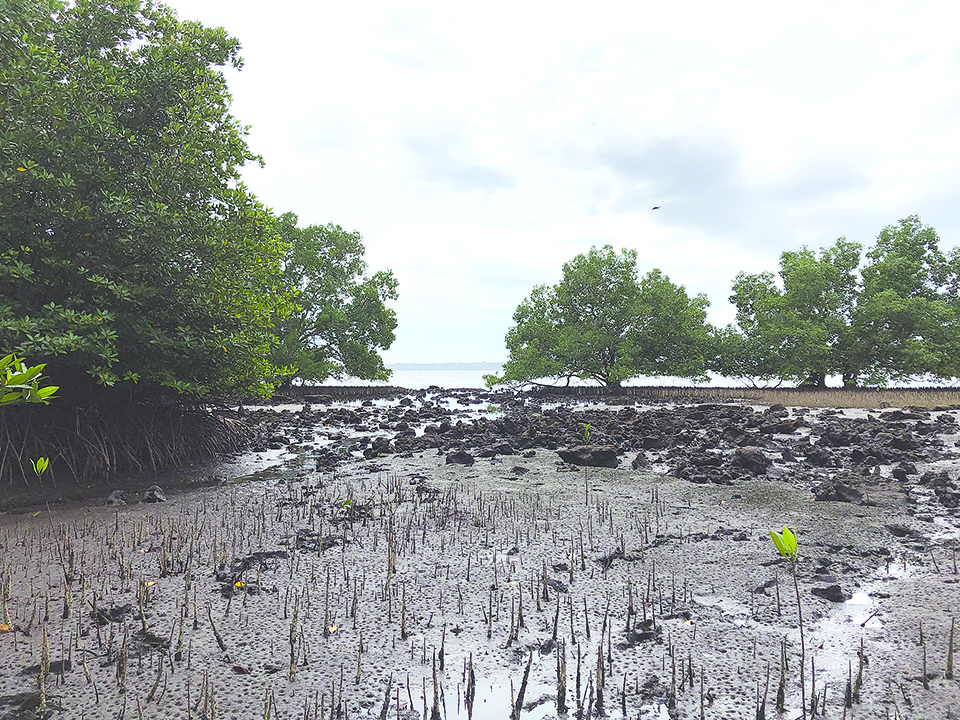
HUMAN IMPACT ON SKIPPER LIFE
Nowadays, Skippers four inches long are very hard to find. This is another of the many telltale signs of our impact on the environment. I remember writing a story for Animal Scene titled Crabs of Palawan. I mentioned that the Ghost Crab or Tagoykoy was so abundant that you could find them in almost any beach in that province. It seems that I have to take my word back.
While a lot of animals have bounced back, it has become glaringly obvious to me that the Ghost Crab has not. Since January of this year, I was able to visit a lot of my beach hangouts – Maruyogon, Talaudjong, Nagtabon, El Nido, Port Barton, White Beach (the one here in Puerto Princesa City). Not only was I not able to spot a mature Ghost Crab, but I was also not able to find a decent crab hole.
This worries me a lot because they used to be so numerous. It is like my beach experiences will never be the same, and I find myself looking for their crab holes every now and then.

MARBLE MARVEL
Fast forward to 2018. When mudskippers came to sample my bait, I grabbed the opportunity to take pictures, since I could never get that close to a Mudskipper. I also used this opportunity to observe it closely.
I could see that the Mudskipper’s eye protrusion was even more pronounced than the Rockskipper’s (see: Mudskipper 1c) because their eyeballs were completely out of their skull. They were like two jolens (marbles) placed on top of their heads.
SLIMY SKIN
Like the Rockskipper, their skin is slimy and smooth, while their body is soft and squishy. If you hold them too tightly, you could dislocate their spine, which could be fatal for the fish as they would no longer be able to skip away from predators or forage properly. (Dear reader, it is therefore best to observe them without holding them; otherwise, the risk that we might harm them is just too high. – Ed.)
LIKE FISH OUT OF WATER
Mudskippers are truly a wonderful creature to behold. They are cute and cuddly, and downright weird. I always have trouble trying to point them out for my visitors to see, because I am always pointing at the mangrove tree trunk while my visitors always look at the water. After all, they are trying to look for fish, so who’d ever think of looking for fish among the trees?
I can go on and on about these cute critters, but I think I have to leave that to another time and encounter, and I hope can take more and better pictures next time.

WHERE CAN YOU FIND SKIPPERS?
Never in my life have I seen Rockskippers, or their cousins the Mudskippers, venture far from the sea, puddle, or swamp, and for good reason. During the night, they stay in small puddles, tiny caves (even caves that are out of water), or dry crevasses, in rocky areas just above the waves (see: Rockskipper’s pool). In this manner, there is no way for predatory fish to climb up the rock to get to them.
Land predators are not so keen to hunt them in this area as well, because this is the area where the waves splash against the rocks. For those who have brought their animal companions to the beach, we know that the noise and the splashing scare the wits out of them.
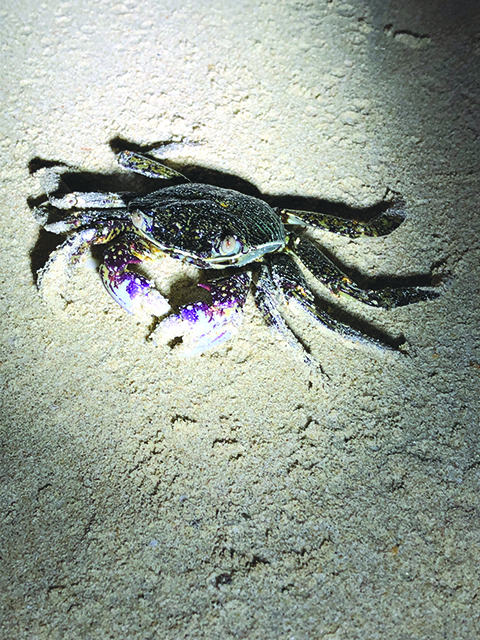
CRABBY COMPANION
Before I end, I feel that the Rockskipper and Mudskipper’s neighbor deserves a bit of time in the spotlight.
Not far from where I found the Rockskippers, I was surprised once more by another creature. Just a few meters towards the sea, and this time in the area where the rocks really meet the waves, I found a number of Lined Shore Crabs.
I was initially taken aback by the rapid rustling noises from the rocks near where I was standing because the sound was very similar to the rustling of leaves when a snake slithered by. It was spooky as I could not see anything when I pointed my flashlight at the rocks. Knowing that there were no leaves and snakes around, I peeked low to see what was rustling between the bottom of the rocks and the wet sand: They were shore crabs of different sizes trying to run away from me.
Shore Crabs are really fast runners and, unlike Ghost Crabs, they are very agile among the rocks. In fact, I dare not chase them for fear of tripping among the jagged rocks or falling into the water.
In my experience of finding dozens of different crabs species, I would say that the Ghost Crab is the hundred-meter dash champion. They are so fast and agile on the sand. But the Shore Crab is the obstacle champion. They cannot run as fast as the Ghost Crab but they can run, twist, turn, and squeeze into or between rocks.

WHAT DO SKIPPERS EAT?
Rockskippers usually go for the algae and plant matter on rocks, while Mudskippers prefer tiny creatures and whatever is left behind by the retreating tide.
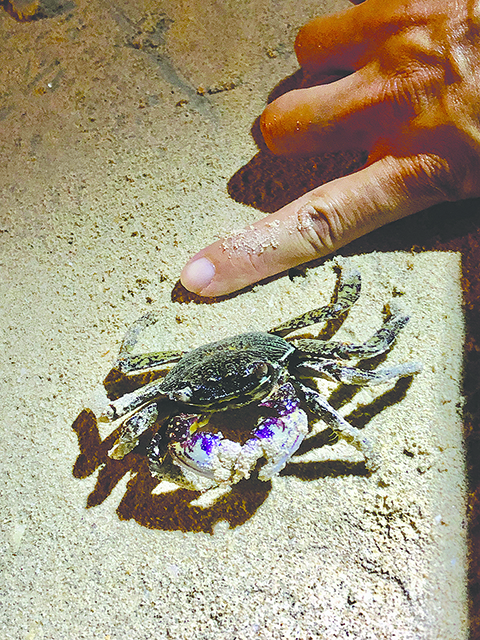
STUNNING SURVIVORS
It was my first time to come in such close contact with a shore crab of this size. I have seen bigger shore crabs, but they were green and not as vibrantly colored as the one I encountered. I am guessing they were probably of different species.
I just have to include this crab into this story because of their beauty.
My daughter (in the photo on the right), who is my third and youngest child and who, you may have realized at this point, has taken after my interest in animals, convinced me to visit the rocky area again the following morning. From where we saw dozens of Rockskippers and Crabs the previous night, we did not see anything in the morning. I assumed that they were probably out foraging. To our delight, we found two molted exoskeletons of the shore crabs.
I could see they were recent molts because they wer still colorful, whole, and hard. Molts bleach easily with their exposure to the elements and they are sometimes eaten by other creatures for the calcium. Exposure to sun and water also make them brittle or soft that they get damaged when lifted out of their place.
I can tell that we had spotted molted exoskeletons because they were light (no flesh), limp (unlike a stiff dead animal), and had an opening on the carapace for the creature to crawl out. There was also no stench (which meant there was no rotting flesh).

That find gave me a sense of comfort, knowing that they were thriving in that area. It was quite sad that their cousin the Ghost Crab, which I used to look down on because of their appetite for newly hatched turtles, was not as fortunate. The numerous constructed structures on the shore and the daily disturbance on the sand really did them in. To think that they used to number in the thousands on those El Nido beaches.
BEFORE WE MISS THEM FOR GOOD
As a businessman, I get asked a lot about why I write these stories. I guess I just want to write about these wonderful creatures because I miss them.
Encountering them again brings so many happy memories from my childhood. Each time I write about them is a bittersweet experience for me, because the fond memories are also accompanied by sadness. I want to believe that these wonderful creatures can be with us for a longer period of time, but the gnawing doubt at the back of my mind just won’t go away.






